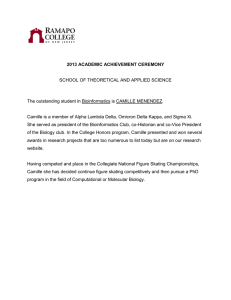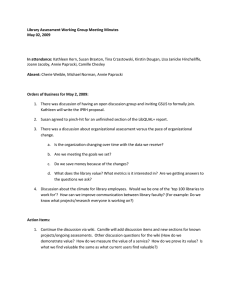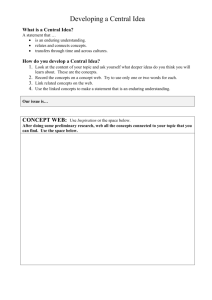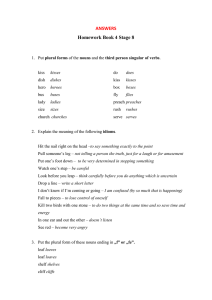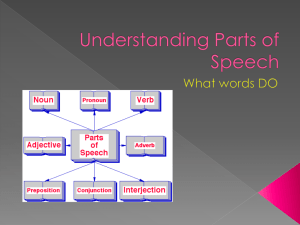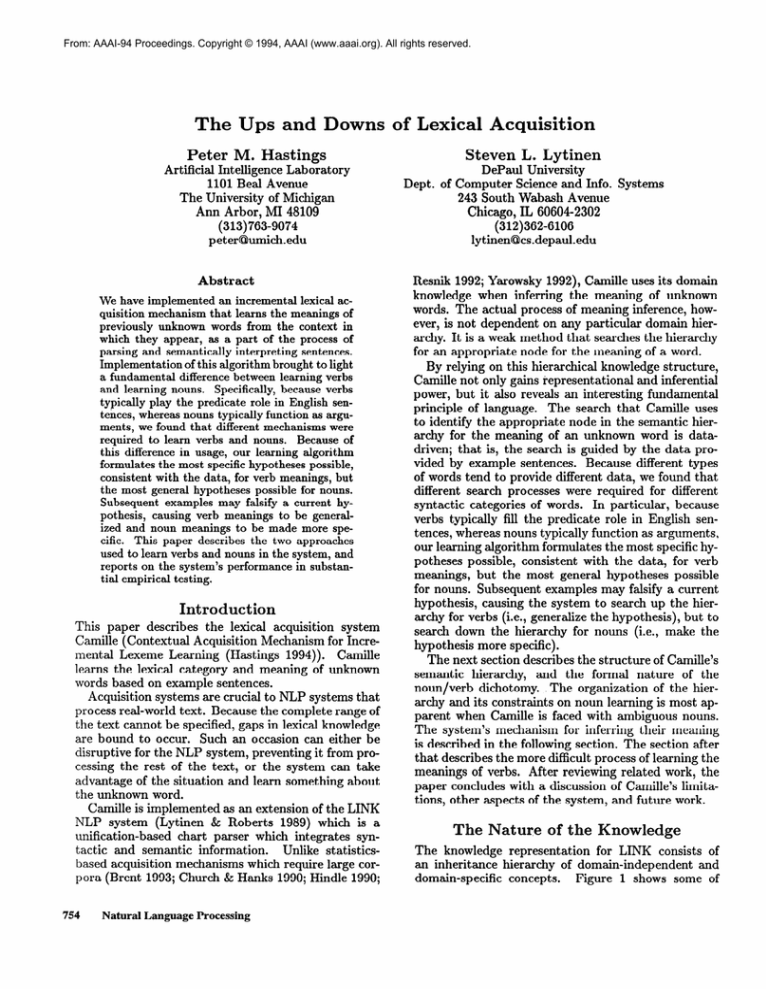
From: AAAI-94 Proceedings. Copyright © 1994, AAAI (www.aaai.org). All rights reserved.
The Ups and Downs
Peter M. Hastings
Artificial Intelligence Laboratory
1101 Beal Avenue
The University of Michigan
Ann Arbor, MI 48109
(313)763-9074
peterQumich.edu
Abstract
We have implemented an incremental lexical acquisition mechanism that learns the meanings of
previously unknown words from the context in
which they appear, as a part of the process of
parsing and semantically interpreting sentences.
Implement at ion of this algorithm brought to light
a fundamental difference between learning verbs
and learning nouns. Specifically, because verbs
typically play the predicate role in English sentences, whereas nouns typically function as arguments, we found that different mechanisms were
required to learn verbs and nouns. Because of
this difference in usage, our learning algorithm
formulates the most specific hypotheses possible,
consistent with the data, for verb meanings, but
the most general hypotheses possible for nouns.
Subsequent examples may falsify a current hypothesis, causing verb meanings to be generalized and noun meanings to be made more specific. This paper describes the two approaches
used to learn verbs and nouns in the system, and
reports on the system’s performance in substantial empirical testing.
Introduction
This paper describes the lexical acquisition system
Camille (Contextual Acquisition Mechanism for Incremental Lexeme Learning (Hastings 1994)). Camille
learns the lexical category and meaning of unknown
words based on example sentences.
Acquisition systems are crucial to NLP systems that
process real-world text. Because the complete range of
the text cannot be specified, gaps in lexical knowledge
are bound to occur. Such an occasion can either be
disruptive for the NLP system, preventing it from processing the rest of the text, or the system can take
advantage of the situation and learn something about
the unknown word.
Camille is implemented as an extension of the LINK
NLP system (Lytinen & Roberts 1989) which is a
unification-based chart parser which integrates syntactic and semantic information.
Unlike statisticsbased acquisition mechanisms which require large corpora (Brent 1993; Church & Hanks 1990; Hindle 1990;
754
Natural Language Processing
of Lexical
Acquisition
Steven L. Lytinen
DePaul University
Dept. of Computer Science and Info. Systems
243 South Wabash Avenue
Chicago, IL 60604-2302
(312)362-6106
lytinenQcs.depaul.edu
Resnik 1992; Yarowsky 1992), Camille uses its domain
knowledge when inferring the meaning of unknown
words. The actual process of meaning inference, however, is not dependent on any particular domain hierarchy. It is a weak method that searches the hierarchy
for an appropriate node for the meaning of a word.
By relying on this hierarchical knowledge structure,
Camille not only gains representational and inferential
power, but it also reveals an interesting fundamental
principle of language. The search that Camille uses
to identify the appropriate node in the semantic hierarchy for the meaning of an unknown word is datadriven; that is, the search is guided by the data provided by example sentences. Because different types
of words tend to provide different data, we found that
different search processes were required for different
syntactic categories of words. In particular, because
verbs typically fill the predicate role in English sentences, whereas nouns typically function as arguments,
our learning algorithm formulates the most specific hypotheses possible, consistent with the data, for verb
meanings, but the most general hypotheses possible
for nouns. Subsequent examples may falsify a current
hypothesis, causing the system to search up the hierarchy for verbs (i.e., generalize the hypothesis), but to
search down the hierarchy for nouns (i.e., make the
hypothesis more specific).
The next section describes the structure of Camille’s
semantic hierarchy, and the formal nature of the
noun/verb dichotomy. . The organization of the hierarchy and its constraints on noun learning is most apparent when Camille is faced with ambiguous nouns.
The system’s mechanism for inferring their meaning
is described in the following section. The section after
that describes the more difficult process of learning the
meanings of verbs. After reviewing related work, the
paper concludes with a discussion of Camille’s limitations, other aspects of the system, and future work.
e
Nature of the
The knowledge representation for LINK consists of
an inheritance hierarchy of domain-independent and
domain-specific concepts.
Figure 1 shows some of
the concepts that are ruled out for an example sentence like “Terrorists froobled the headquarters.” It is
important to note that this is not just an artifact of
LINK’s knowledge representation structure. It is due
to a fundamental principle of language. Because actions serve as the relational elements of sentence structure, they are the only logical place for the constraints
to reside.
Because of this dichotomy, Camille must have different strategies for learning verbs and learning nouns.
They can be stated most succinctly as follows:
nouns,
choose
the most general
hypothesis.
For verbs,
hypothesis.
choose
the most specific
For
Figure 1: The pruned object tree
LINK’s domain-specific object concepts from the Terrorism domain that served as the testing ground for
ARPA’s third and fourth Message Understanding Conferences (Sundheim 1992) (the shading will be explained later). The structure of the hierarchy forms
an IS-A inheritance tree. Figure 2 shows some of the
actions from the domain. Action concepts provide the
relational structure that binds together the representation of the meaning of sentences. These concepts also
constrain the types of arguments that can be attached
as their slot-fillers (also included in fig 2).
The nodes in LINK’s concept hierarchy serve as its
basic units of meaning. Learning the meaning of an unknown word reduces to finding the appropriate node in
the hierarchy - a graph search problem. To drive the
search, the semantic constraints, which are normally
used to limit attachment of slot-fillers to the Head verb,
interact with the evidence provided by example sentences. But the interaction works in different ways for
different classes of words. Nouns (as the Heads of noun
phrases) normally serve as the slot-fillers of sentences
and thus, as the items which are constrained. For example, in the sentence “Terrorists destroyed a flarge,”
the word “destroy” refers to the concept Destroy which
has the constraint [Object = Phys-Targ]. When “flarge”
is attached as the object of the verb, the constraint
places an upper bound on its interpretation as shown
in figure 1. Tl le shaded-out nodes camlot be a valid
interpretation of the meaning of “flarge”.
For unknown verbs, however, the situation is quite
different. Because they usually map to the actions in
the domain, the verbs apply the constraints. Thus, the
constraints place an upper bound on the interpretation
of unknown verbs.’ The shaded areas of figure 2 show
‘Note that negative examples, for example, “You can’t
say ‘Terrorists
froobled the civilians”‘,
would provide the
opposing
bound
(upper for unknown
verbs, lower for
nouns).
Then Mitchell’s
candidate-elimination
approach
(Mitchell 1977) t o narrowing the hypothesis set might work.
Unfortunately,
negative examples are rare in human speech
consistent
This difference is prescribed by the nature of the knowledge and it is consonant with psycholinguistic theories
which maintain that humans treat verbs and nouns
differently (Gentner 1978; Huttenlocher & Lui 1979;
Graesser, Hopkinson, & Schmid 1987; Behrend 1990;
Fernald SCMorikawa 1993).
The implications of the noun-learning strategy are
seen most clearly in the acquisition of ambiguous nouns
as described in the next section. The following section describes the more difficult acquisition problem
for verbs.
Learning Ambiguous Nouns
Word sense ambiguity has been a thorn in the side of
NLP for a long time (Small & Cottrell 1988). The majority of the research on this issue has targetted methods for selecting the appropriate sense of an ambiguous word. For lexical acquisition, a different problem
exists: how can a system recognize that a word has
multiple senses and make a suitable definition?
If the system cannot learn ambiguous words, it will
run into a parsing impasse. Consider two examples of
the use of the word “lines” taken from the Terrorism
corpus:
have broken the defensive
lines of the
enemy.
The Lempa River Hydroelectric
Commission
reported
that one of the country’ls
main power
lines was out of service
on I June because a
number of pylons were destroyed.
We
If the system does not know the word “lines” when it
encounters the first sentence, it should infer a meaning
like Military-Unit because within the domain, that is
likely to be the target of Break. If the system cannot
recognize ambiguity while processing the second sentence, it will either create an erroneous parse or fail
altogether. Camille creates definitions for ambiguous
and non-existent
in this and most other
information extrac-
tion domains.
Lexical Acquisition
755
Figure 2: The pruned action tree
nouns through a simple extension of its noun-learning
mechanism.
As previously stated, the constraints on actions provide an upper bound for the interpretation of unknown
nouns. This provides the basis for a simple and elegant
mechanism to acquire noun meanings. When an unknown noun is attached as the slot filler of a verb,2 the
unification procedure (because it returns the more specific concept) gives the representation of the meaning
of that word the concept specified by the constraint.
All Camille must do is to collect these induced definitions after the parse is complete.
When a word is ambiguous, the parser will try
to unify incompatible concepts (Military-Unit and
Electricity-Source in the example above).
If the initial definition was inferred by Camille, however, it is
marked as tentative. The unification procedure was extended to recognize such a situation and to infer a disjunctive definition for the word, for example (MilitaryUnit V Electricity-Source).
This mechanism was tested by removing the definitions of all 9 of the ambiguous nouns within the Terrorism domain: branch, charge, lines, others, plant, post,
quarter, state, and system.3 Although many of these
2Camille’s morphology component provides some indication of the lexical category of an unknown word. Consistent interpretations are entered into the parse. The application of syntactic constraints is usually sufficient to resolve
the word’s lexical category.
3Like the word “others”, some additional words in the
lexicon were vague. ((Lytinen 1988) also contains a dis-
756
Natural Language Processing
words were not “targets” for the domain (i.e. they were
not specified as interesting for the information extraction task), Camille, after processing 100 examples from
the corpus which contained the words, created ambiguous definitions for five of the nine words: lines, others,
post, state, and system.4
The scoring system used in the MUCs was adapted
to facilitate evaluation of the empirical tests of
Camille’s lexical acquisition. The measures were defined as: Recall is the number of correct hypotheses5
created by the system divided by the total number of
undefined words. Precision is the number of correct
concepts in the hypotheses divided by the total number of concepts generated. Accuracy is the number of
correct hypotheses divided by the number of hypotheses generated.
The system hypothesized 5 out of 9 ambiguous definitions. Recall, counting the correct definitions, was
8 out of 18 possible definitions, or 44%. Precision and
Accuracy were 8 out of 12, or 67%. As will be shown
cussion of dealing with vague versus ambiguous words.)
“0 thers” was the only vague word tested because it occurred prominently in such examples as, “11 others were
wounded.”
41t also created single definitions for many other words
that had been overlooked in the system development.
For example the word “impunity” was inferred to be an
Instrument-Object.
51n this paper, a hypothesis refers to a set of concepts
that Camille generates as the tentative meaning of an unknown word.
in the next section, these scores are more descriptive
for the larger verb-learning tests.
The importance of the ambiguity mechanism to the
noun/verb dichotomy is that it highlights the difference between the conservative and liberal approaches
to meaning inference. The conservative approach selects the concept specified by the verb’s constraint because it is consistent with the data. The liberal approach searches under that concept for a more specific
node (perhaps one which is not already the label of
some other word).’
As described in the next section, when learning verb
meanings, Camille must take a liberal approach, favoring the most specific hypotheses, in order to get usable,
falsifiable hypotheses. For learning ambiguous nouns,
Camille must use the the conservative approach. If the
system used the liberal approach and later encountered
a conflicting use of the noun, Camille would not know
if it had found an ambiguous word, or if it had made
a wrong initial guess about the referent of the word.
This produces the two-part strategy described above.
Learning Verbs
As previously mentioned, verbs tend to play the role
of the predicate in language. Thus, they serve to organize the overall semantic structure of a sentence, with
arguments such as the subject and direct object attaching to them in various “slots.” This makes verbs
both more important and more difficult to learn, since
a sentence with an unknown verb is missing its head
concept.
As with nouns, Camille learns verb meanings by
searching through the concept hierarchy for an appropriat e concept . Because the knowledge representation imposes a lower bound on the interpretation of
unknown verbs, the system must either settle for an
overly general hypothesis (for example: Action but not
Hijacking or Kidnapping) or inductively set its own upper bound. In order to increase the usability and the
falsifiability of its hypotheses, Camille takes the latter
approach.
To learn nouns, the system merely applied the constraints from the actions to the unknown slot fillers.
Because verbs refer to the actions, however, the system camrot know which constraints apply. It must
therefore infer the meaning of an unknown verb by
comparing the slot fillers that are attached to it with
the constraints of the various action concepts. Camille
does this incrementally, adjusting the definition as each
slot filler is attached, and as each example of the word’s
use is processed.
As when it learns nouns, the system initially places
a default definition into the parse structure for an unknown verb and gives it the default meaning Action.
6A psycholinguistic theory, Mutual Exclusivity (Markman 1991), suggests that children use a similar approach to
“fill gaps” in their lexical knowledge and thereby reduce the
computational complexity of their early lexical acquisition.
As each slot filler is attached, Camille checks which
descendants of the current meaning hypothesis have
constraints that are compatible with the slot filler.
For example, with the sentence, “Terrorist froobled the
headquarters”, “headquarters” is initially attached as
the Object of “froobled”. All of the non-shaded nodes
in figure 2 have constraints which are consistent with
this Object. Because Camille wants to induce an upper
bound on this hypothesis set, it eliminates from consideration all but the most specific members of this set.
That is, if any node in the set is the parent of another
node in the set, the parent is eliminated. To make the
set even more specific, the distance in the hierarchy
between the slot-filler concept and the constraint concept is computed for each concept, and only the closest
matches are kept in the hypothesis set. For example,
Arson’s Object constraint is Building which is the parent of Headquarters and therefore has a distance of one.
Human-or-Place, the Object constraint for Attack has
a distance of four from Headquarters, so Attack is removed from consideration. This process is repeated as
each slot filler is attached for this and future sentences.
After each sentence is processed, Camille stores new or
modified word definitions in the lexicon.
By trimming down the hypothesis set as described,
Camille would infer the single concept Arson as the
meaning of “frooble”. Note that other concepts (Attack and Bombing, for example) are consistent with
the evidence, but these concepts would not be as easily disconfirmed. For example if the system encountered the sentence, “Terrorists froobled the pedestrians”, the Arson hypothesis would be disconfirmed but
not the others. This is a key to Camille’s success in
learning word meanings. By choosing the most specific
concepts, Camille makes the most falsifiable hypotheses. Thus further examples will be more likely to conflict with an initial hypothesis, invoking the generalization procedure. This procedure searches the hierarchy
starting at the current hypothesis until a concept is
found which has constraints that do not conflict with
all of the slot fillers that have been encountered. If
another example of the the unknown word does not
conflict with the initial hypothesis, the falsifiability of
that hypothesis increases the likelihood that it was correct.
To empirically test Camille’s verb-learning mechanism, 50 sentences were randomly selected from the
corpus. The definitions of the 17 verbs from those sentences were removed from the lexicon. The average
length of the sentences was 24 words, and the average
number of repetitions of each unknown word was 2.7.
After processing the sentences, Camille had produced
15 hypotheses of which 7 were correct (i.e. the hypothesis set included a correct concept). The average
number of concepts per hypothesis was 2.5. This resulted in scores of 41% Recall, 19% Precision, and 47%
Accuracy.7 For comparison, the average of six runs in
‘Camille was also tested in another domain which conLexical Acquisition
757
which meaning assignments were generated randomly
from a weighted distribution produced scores of 22%
Recall, 10% Precision, and 23% Accuracy.
Related Work
Other systems have concentrated on the acquisition of
specific kinds of words. Granger noted the importance
and difficulty of acquiring verbs in his description of
Foul-Up (Granger 1977) which used heuristic methods
to learn verbs based on the prepositions in a sentence.
Zernik’s Rina (Zernik 1987) concentrated on learning
verb-particle combinations using interactive training
and extensive domain knowledge. Unfortunately, neither was evaluated on real-world data. The extent of
special-purpose knowledge that these systems required
would have made that extremely difficult to do.
Salveter, Selfridge, and Siskind have developed cognitive models which perform lexical acquisition (Salveter 1979; Selfridge 1986; Siskind 1990). These systems are interesting from the psychological point of
view, but they each focus on such a limited acquisition task as to render them inapplicable to real-world
processing.
On the other hand, Cardie’s and Riloff’s systems
(Cardie 1993; Riloff 1993) were specifically oriented
toward the processing of real-world texts.
Cardie’s
case-based system, MayTag, did not infer meanings
for verbs though.
Riloff’s AutoSlog
learned what
amounted to pattern-based production rules. One rule,
for example, matched on some subject noun phrase
followed by the passive tense of “kidnap” and then assigned the subject to the victim slot of a database form
which described the text. These rules could be viewed
as definitions for the words. But the system knew so
little .about the words that it required separate rules
for active and gerund uses of the same word. It also
required a separate set of rules for related words like
“abduct”. AutoSlog created a large set of rules which
required filtering by a human user. Both AutoSlog and
MayTag were batch systems which performed one-shot
learning.
Although the scores reported above for Camille’s
performance are significantly lower than the hit rates
reported by Cardie’s system, which was also set within
an information extraction task, Cardie’s scores were
combined scores of all different lexical categories, and,
as mentioned previously, MayTag made no concept hypotheses for verbs.
Camille’s approach to lexical acquisition is incremental so its processing and storage requirements are minimized. The system learns automatically from example
tained much simpler sentences (average length: 4.3 words).
Scores in this domain were considerably higher: Recall
?I%, Precision 22%, and Accuracy 76%. As discussed below, the complexity of the test sentences in the Terrorism
domain cqnsiderably decreased Camille’s ability to learn
because it received noisy data.
758
Natural Language Processing
sentences so it does not require guidance from a human trainer. Camille doesn’t need additional knowledge sources. It uses only the knowledge that is present
for standard parsing.
Limitations and Future Work
An obvious limitation of the system as it is described
here is that it assumed that every aspect of meaning
about the domain was a prioti represented in the concept hierarchy. This conflicts with our intuitions that
lexical and concept learning interact, at least to some
extent. Another aspect of Camille’s implementation
partially addresses this limitation, allowing the addition of object nodes. Because Camille has no other
window on the world than its linguistic input, however, learning action concepts is a much more difficult
problem and will be left to future research.
The basic Camille approach does have some weaknesses. The production of large sets of concepts in
hypotheses was not completely mitigated by the elimination of less-specific concepts. Many sets of concepts
remain that are indistinguishable based only on the
use of slot fillers. The full implementation of Camille
also includes a mechanism which uses scripts (Schank
& Abelson 1977; Cullingford 1977) to further refine
hypotheses.
The learning procedure is sensitive to noisy input.
Because it uses an inductive procedure, Camille assumes that if one of its hypotheses conflicts with subsequent evidence, then the original guess was incorrect and the hypothesis should be altered. Noise can
be produced by a number of sources, most commonly
incomplete parses and ungrammatical input. The domains on which Camille has been tested contain mostly
grammatical text. The Terrorism corpus was so complex, however, that it caused great difficulty for the
parser, and incorrect or incomplete parses were common.
(Camille always produces definitions for unknown verbs that it encounters. The fact that it created no definitions for 2 of the 17 in the test set signifies that no parses or parse fragments containing these
words were passed to Camille.) Noisy input can cause
Camille to infer that a word takes a larger range of slotfillers. As a result, the system will make an overly general hypothesis for a word’s meaning. One approach
to handling noise is suggested by the Camille’s mechanism which handles ambiguous words. The implementation of this addition is left to future research.
Because Camille was implemented with the goal of
using only the knowledge that LINK requires for parsing, it is unable to make certain inferences about word
meaning. The representation for action concepts describes only their names, their IS-A relationships to
each other, and their constraints on slot fillers. Although the script mechanism allows Camille to make
inferences based on sequences of actions, the system
has no knowledge of the results of actions, their causes,
or what goals they might achieve. The addition of such
knowledge would enhance Camille’s learning abilities,
but it would also impose an additional resource requirement .
Conclusion
The task of lexical acquisition for Camille reduces to
searching for an appropriate node in the domain representation. This abstraction of the task reveals an important distinction between learning nouns and learning verbs. The constraints on actions provide a natural upper bound on the interpretation of unknown
object labels. For action labels, no such upper bound
exists. Thus, in order for Camille to make useful inferences about verb meanings, it must ‘inductively limit
its search space. Camille does this by choosing the
most readily falsifiable hypotheses. This gives Camille
the best chance for correcting its mistakes. Thus the
system uses a two-part strategy to quickly converge on
an appropriate hypothesis for many unknown words.
References
Behrend, D. 1990. The development of verb concepts:
Children’s use of verbs to label familiar and novel
events. Child Development 61:681-696.
Brent, M. 1993. Surface cues and robust inference as
a basis for the early acquisition of subcategorization
frames. Lingua. in press.
Cardie, C. 1993. A case-based approach to knowledge
acquisition for domain-specific sentence analysis. In
Proceedings of the 11th National Conference on Artificial Intelligence, 798-803.
Church, K., and Hanks, P. 1990. Word association
norms, mutual information, and lexicography. Computational Linguistics 16.
Cullingford, R. 1977. Organizing World Knowledge
for Story Understanding by Computer. Ph.D. Dissertation, Yale University, New Haven, CT.
Fernald, A., and Morikawa, H.
1993. Common
themes and cultural variations in Japanese and American mothers’ speech to infants. Child Development
64:637-656.
Gentner, D. 1978. On relational meaning: The acquisition of verb meaning. Child Development 49:988998.
Graesser,. A.; Hopkinson, P.; and Schmid, C.
1987. Differences in interconcept organization between nouns and verbs. Journal of Memory and Language 26~242-253.
Granger, R. 1977. Foul-up: A program that figures
out meanings of words from context. In Proceedings
of Fifth International
Joint Conference on Artificial
Intelligence.
Hastings, P. 1994. Automatic Acquisition of Word
Meaning from Context. Ph.D. Dissertation, University of Michigan, Ann Arbor, MI.
Hindle, D. 1990. Noun classification from predicateargument structures. In Proceedings of the 28th Annual Meeting of the Association for Computational
Linguistics, 268-275.
Huttenlocher, J., and Lui, F. 1979. The semantic
organization of some simple nouns and verbs. Journal
of verbal learning and verbal behavior 18:141-162.
Lytinen, S., and Roberts, S. 1989. Unifying linguistic
knowledge. AI Laboratory, Univ of Michigan, Ann
Arbor, MI 48109.
Lytinen, S. 1988. Are vague words ambiguous? In
Small, S., and Cottrell, G., eds., Lexical Ambiguity
Resolution. San Mateo, CA: Morgan Kaufmann Publishers. 109-128.
Markman, E. 1991. The whole object, taxonomic, and
mutual exclusivity assumptions as initial constraints
on word meanings. In Byrnes, J. P., and Gelman,
S. A., eds., Perspectives on language and thought: Interrelations in development.
Cambridge: Cambridge
University Press.
Mitchell, T. 1977. Version spaces: A candidate elimination approach to rule learning. In Proceedings of
the Fifth International
Joint Conference on Artificial
Intelligence, 305-309.
Resnik, P. 1992. A class-based approach to lexical
discovery. In Proceedings of the 30th Annual Meeting of the Association for Computational
Linguistics,
327-329.
Riloff, E. 1993. Automatically constructing a dictionary for information extraction tasks. In Proceedings
of the llth National Conference on Artificial Intelligence, 811-816.
Salveter, S. 1979. Inferring conceptual graphs. Cognitive Science 3: 141-166.
Schank, R., and Abelson, R. 1977. Scripts, plans,
goals, and understanding.
Hillsdale, NJ: Lawrence
Erlbaum Associates.
Selfridge, M. 1986. A computer model of child language learning. Artifkial Intelligence 29:171-216.
Siskind, J. 1990. Acquiring core meanings of words.
In Proceedings of the 28 Ih Annual Meeting of the Association for Computational
Linguistics, 143-156.
Small, S., and Cottrell, G., eds. 1988. Lexical Ambiguity Resolution. San Mateo, CA: Morgan Kaufmann
Publishers.
Sundheim, B. 1992. Overview of the fourth message
understanding evaluation and conference. In Proceedings of the Fourth Message Understanding
Conference. San Mateo, CA: Morgan Kaufmann Publishers.
Yarowsky, D. 1992. Word-sense disambiguation using
statistical models of roget’s categories trained on large
corpora. In Proceedings, COL ING- 92.
Zernik, U. 1987. Strategies in language acquisitions:
Learning phrases from examples in context. Technical
Report UCLA-AI-87-1, UCLA.
Lexical Acquisition
759

